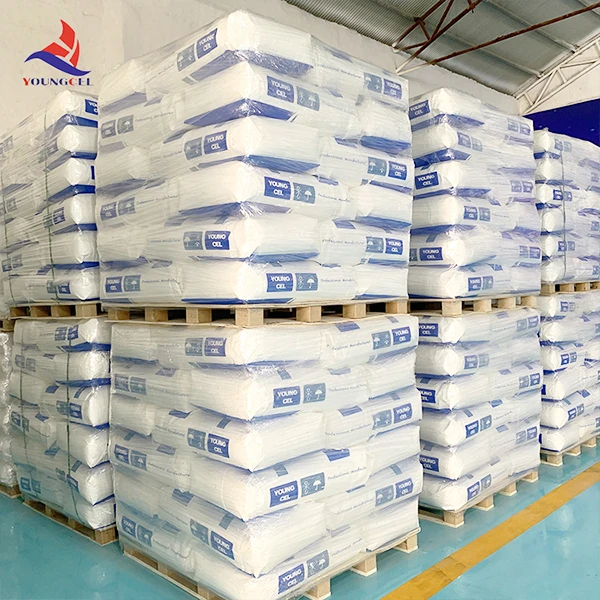Understanding HPMC Hydroxypropyl Methylcellulose
Hydroxypropyl methylcellulose (HPMC) is a versatile and widely used cellulose derivative that has garnered significant attention in various industries due to its unique properties and functionalities. Derived from naturally occurring cellulose, HPMC is a non-ionic polymer that is synthesized by the partial substitution of hydroxyl groups in cellulose with hydroxypropyl and methyl groups. This modification enhances its solubility and performance in different applications, making it an invaluable ingredient in pharmaceuticals, food, construction, and personal care products.
Key Properties of HPMC
One of the most significant features of HPMC is its ability to form clear and stable solutions in water, depending on its grade and concentration. It is available in different viscosity grades, which allows for tailored viscosity adjustment in formulations. This property is particularly useful in the pharmaceutical industry, where it serves as a thickening agent, binder, and film-forming agent in various drug formulations, including tablets and gels.
In addition to its viscosity traits, HPMC exhibits excellent gelation properties when heated, followed by a cooling process, creating thermoreversible gels. This characteristic is crucial in food applications, where HPMC is used as a thickener or stabilizer in sauces, dressings, and bakery products. It serves to improve texture and enhance mouthfeel, which is critical for consumer satisfaction.
Another noteworthy property is HPMC's excellent film-forming abilities, allowing it to create a protective barrier on surfaces. This property finds extensive applications in the personal care industry, where HPMC is used in formulations such as lotions, shampoos, and hair styling products. Its ability to retain moisture and improve skin feel makes it a preferred ingredient in many cosmetic formulations.
Applications of HPMC
hpmc cellulose hydroxypropyl methyl

HPMC’s versatility is reflected in its wide range of applications across different industries. In the pharmaceutical sector, its role as a controlled-release agent enhances the bioavailability of drugs, allowing for sustained therapeutic effects. It is often used in the formulation of hydrophilic matrix tablets, where it regulates the release of active ingredients over extended periods.
In the food industry, HPMC is recognized as a food additive, often labeled as E464. It is utilized for its thickening, gelling, and stabilizing properties. As health-conscious trends evolve, HPMC provides a gluten-free alternative for traditional baking, making it an essential ingredient for gluten-free products and gluten-free cuisines.
The construction industry has also embraced HPMC for its water retention properties and ability to improve the workability of cementitious materials. It is commonly used in dry-mixed mortars, tile adhesives, and plaster, contributing to better adhesion, flexibility, and water resistance.
Environmental Considerations
As a cellulose derivative, HPMC is regarded as a more sustainable alternative compared to synthetic polymers. Its biodegradable nature allows it to decompose without leaving harmful residues in the environment. This has led to a growing interest in HPMC as a green ingredient in various applications, particularly as consumers become increasingly aware of environmental issues.
Conclusion
Hydroxypropyl methylcellulose is a remarkable compound that bridges multiple industries, thanks to its unique properties and versatility. Whether it is enhancing pharmaceutical formulations, improving food texture, or providing eco-friendly solutions in construction, HPMC stands out as a multifunctional ingredient. As research and development continue to explore its full potential, HPMC is likely to play an even more significant role in innovative applications, underscoring the importance of natural derivatives in modern industries.
-
A Comprehensive Guide to Methyl Ethyl Hydroxyethyl Cellulose: Applications and Industry InsightsNewsNov.24,2025
-
Understanding Methyl 2 Hydroxyethyl Cellulose: Uses, Benefits & Industry InsightsNewsNov.24,2025
-
Hydroxyethyl Methyl Cellulose HEMC: Industrial Uses, Benefits & Future TrendsNewsNov.23,2025
-
HEMC Cellulose: Versatile & Sustainable Industrial Polymer | YoungcelNewsNov.23,2025
-
Methyl Hydroxyethyl Cellulose: Versatile Building Block for Industry & SustainabilityNewsNov.23,2025
-
CAS 9032 42 2: Understanding Polyvinyl Alcohol's Impact on Industry & SustainabilityNewsNov.22,2025




